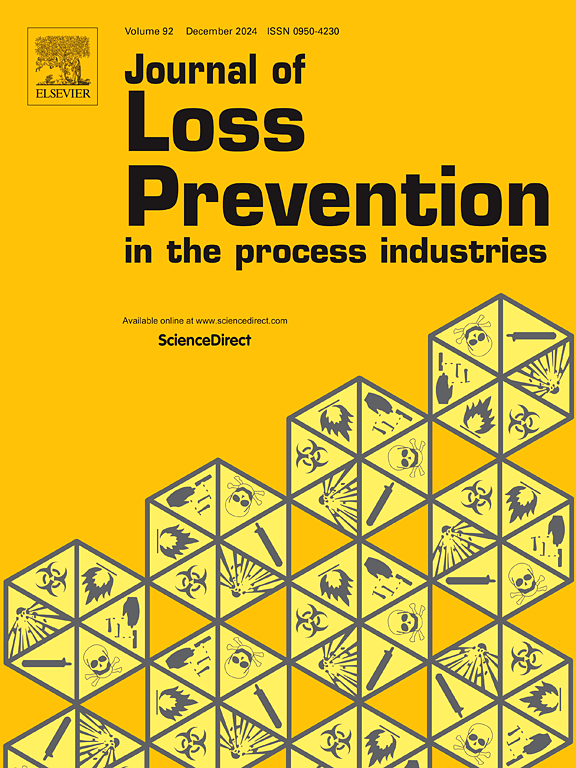175 MPa超高压井喷混合气体燃烧爆炸敏感性及危险性研究
IF 4.2
3区 工程技术
Q2 ENGINEERING, CHEMICAL
Journal of Loss Prevention in The Process Industries
Pub Date : 2025-06-20
DOI:10.1016/j.jlp.2025.105715
引用次数: 0
摘要
目前,超深井井下压力可达175 MPa,在这种条件下井喷的危险性显著增加。然而,圣诞树控制系统的安全距离尚未得到有效确定,主要原因是缺乏对气体点火条件的准确评估。为科学评价超高压混合气体在超深井井喷燃烧爆炸危险性,本研究开展了点火实验,建立了理论预测模型,综合分析了175 MPa下混合气体的点火敏感性参数和爆炸危险性。结果表明,将点火能量从20 mJ提高到1000 mJ时,爆炸下限LEL降低了13.77%;将热表面点火温度从820℃提高到1600℃时,爆炸下限LEL降低了11.92%。在井喷条件下,爆炸超压从1.90 bar降至0.94 bar,几乎减半,火焰温度从754.21℃降至621.34℃,表明爆炸严重程度大幅降低。随着初始压力的增加,相同半径的球形火焰表面出现的裂纹较少,表明火焰稳定性增强。基于热力学和传热学理论,结合能量损失机理分析,建立了井喷混合气体最小点火能的理论预测模型。模型的预测误差在30%以内。该研究为超高压深层油气储层井喷燃烧爆炸风险的防治提供了科学依据。本文章由计算机程序翻译,如有差异,请以英文原文为准。
Study on the sensitivity and hazard of combustion and explosion in 175 MPa ultra-high pressure blowout gas mixtures
At present, the underground pressure of ultra-deep wells can reach up to 175 MPa, making blowouts under such conditions significantly more hazardous. However, the safety distance for the control system of the Christmas tree has not yet been effectively determined, primarily due to the lack of accurate assessment of the gas ignition conditions. To scientifically evaluate the blowout-induced combustion and explosion risks of ultra-high-pressure gas mixtures in ultra-deep wells, this study conducted ignition experiments and developed a theoretical prediction model to comprehensively analyze the ignition sensitivity parameters and explosion hazards of gas mixtures at 175 MPa. The results show that increasing the ignition energy from 20 mJ to 1000 mJ lowers the lower explosion limit (LEL) by 13.77 %, while raising the hot surface ignition temperature from 820 °C to 1600 °C reduces the LEL by 11.92 %. Under blowout conditions, the explosion overpressure decreases from 1.90 bar to 0.94 bar—cut nearly in half—and the flame temperature drops from 754.21 °C to 621.34 °C, indicating a substantial reduction in explosion severity. With increasing initial pressure, fewer cracks appear on the surface of spherical flames of the same radius, suggesting enhanced flame stability. Based on thermodynamic and heat transfer theory, a theoretical prediction model for the minimum ignition energy (MIE) of blowout gas mixtures was proposed, incorporating analysis of energy loss mechanisms. The model's prediction error remains within 30 %. This study provides a scientific foundation for the prevention and control of combustion and explosion risks associated with blowouts in ultra-high-pressure, deep oil and gas reservoirs.
求助全文
通过发布文献求助,成功后即可免费获取论文全文。
去求助
来源期刊
CiteScore
7.20
自引率
14.30%
发文量
226
审稿时长
52 days
期刊介绍:
The broad scope of the journal is process safety. Process safety is defined as the prevention and mitigation of process-related injuries and damage arising from process incidents involving fire, explosion and toxic release. Such undesired events occur in the process industries during the use, storage, manufacture, handling, and transportation of highly hazardous chemicals.

 求助内容:
求助内容: 应助结果提醒方式:
应助结果提醒方式:


